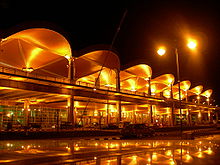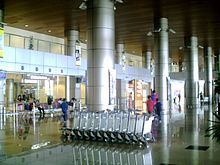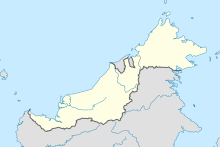Kuching International Airport
Kuching International Airport Lapangan Terbang Antarabangsa Kuching 古晋国际机场 | |||||||||||
|---|---|---|---|---|---|---|---|---|---|---|---|
 | |||||||||||
| Summary | |||||||||||
| Airport type | Military/Public | ||||||||||
| Owner | Government of Malaysia | ||||||||||
| Operator | Malaysia Airports Holdings Berhad | ||||||||||
| Serves | Kuching Division & Samarahan Division, Sarawak, East Malaysia | ||||||||||
| Location | Kuching, Sarawak, East Malaysia | ||||||||||
| Hub for | AirAsia Hornbill Skyways Malaysia Airlines MASwings | ||||||||||
| Time zone | MST (UTC+08:00) | ||||||||||
| Elevation AMSL | 89 ft / 27 m | ||||||||||
| Map | |||||||||||
 | |||||||||||
| Runways | |||||||||||
| |||||||||||
| Statistics (2013) | |||||||||||
| |||||||||||
Kuching International Airport (Initialized: KIA) (IATA: KCH, ICAO: WBGG) is an international airport serving the entire southwestern region of Sarawak, Malaysia. It is located 11 km (6.8 mi)[2] south of Kuching city centre. The airport also shares its runway with the RMAF Kuching Airbase, home to the No. 7 Squadron RMAF.[3]
The airport terminal is capable of handling five million passengers per annum and it is the fourth busiest airport in Malaysia. KIA has grown rapidly with an increasing number of passengers and aircraft movement. In 2010, KIA handled 3,684,000 passengers with a corresponding volume of 46,382 flights. In the same year, 26,977 metric tonnes of cargo were handled through this facility.
KIA is the secondary hub for Malaysia Airlines and has been growing rapidly to tackle the demand of the travellers in the East Malaysia region.
History
The airport was built by the British Government of Sarawak in the 1940s on the outskirts of Kuching town. It was opened for use on 26 September 1950. The airport consisted of a small "L" shaped single storey passenger terminal, a small cargo facility, and an airport fire station. Air Traffic Control Tower, Meteorological Service and Maintenance building were clustered in one area, a small apron of 4 parking bays and a single runway which was 1372 metres long and 46 metres wide. Navigational (Directional Finding Equipment) and Radio Aids were installed at the airport.
Kuching International Airport then became the gateway to Sarawak, Brunei and North Borneo (Sabah as it is called today) with the introduction of once weekly Douglas Dakota twin-engined piston aircraft services originating from Singapore. By the end of 1954, scheduled air services into Kuching International Airport grew by leaps and bounds. This was depicted in the 1954 statistics which recorded 1550 aircraft movements, 13,564 passengers, 95,911 kilogrammes of cargo and 25,984 mails. In 1959, the runway was extended to 1555 metres in length to make way for Vickers Viscount turboprop aircraft operations.
In 1962, the runway was extended once more to a length of 1921 meters to facilitate DeHavilland Comet-4 turbojet aircraft operations. The terminal was also enlarged in the same year. A Control Zone was established at Kuching in November as a part of a plan to provide an Air Traffic Control Service commensurate with the growth of air traffic. Malayan Airways Limited operated the Singapore / British Borneo Territories Regional Services with Vickers Viscount and Douglas DC-3 aircraft, daily schedules linked Kuching and Sibu with Singapore on the other side, and Brunei and Borneo on the other.
In 1971, the Malaysian Government (as Sarawak joined the Federation of Malaysia on 16 November 1963) engaged a team of Canadian Consultants to make a Master Plan study of Kuching International Airport.
In December 1972, the government accepted the Consultant's report. Among the recommendations were:
- The extension and strengthening of existing runway to enable operations by larger jet-powered aircraft
- The construction of a new terminal building on the north site of the runway
Work on the strengthening and extension of the runway to 2,454 metres (8,051 ft) in length started in 1973 and was completed in 1976, capable of handling Boeing 707 turbofan aircraft.
In 1980, consistent with the advent of Airbus A300B4 operations, it was imperative that the runway pavement strength be upgraded to meet the requirements of that particular aircraft. Work on this was completed in early 1982.
Construction of the terminal complex at the north site took a centre stage at the end of 1978 and was completed in July 1983. This modern terminal replaced the previous terminal, and was opened for business on 24 August 1983. The terminal complex covered a built-up area of 81 hectares with a floor space of 13,000 square metres, comprised the three-storey passenger terminal flanked by neatly planned buildings which consisted of the Air Traffic Control Tower and operations block, a larger freight facility, a new airport fire station, Maintenance Building, VIP Building and ancillary services building.
As of 1999, two foreign airlines (Singapore Airlines and Royal Brunei Airlines) from both Singapore and Brunei as well as Malaysia's national carrier and as many as 8 private general aviation companies operated scheduled services into and out of Kuching International Airport. Non-scheduled charter flights were also operated by two foreign airlines. As of 2013, however, four of Malaysia's airlines (Malaysia Airlines, MasWings, Air Asia and Malindo Air) as well as three cargo operators (MASKargo, Transmile Air Services and Neptune Air) operate to and from Kuching International Airport. Four foreign airlines have since discontinued their services to Kuching (Singapore Airlines, Royal Brunei Airlines, Jetstar Asia, and Tiger Airways). A further two continue to operate services into Kuching (Express Air and SilkAir).
As a result of the increasing number of passengers going into and out of Kuching, a completely new and larger terminal was needed. Construction started in the early 2000s, and progressed at an incredible pace. The new terminal was literally constructed from the inside out, with the old terminal slowly being chipped away and replaced by new sections of the new terminal. The new terminal complex was finally opened on Monday, the 16th of January 2006 by the Chief Minister of Sarawak Pehin Sri Haji Abdul Taib Mahmud and the then Malaysian Minister of Transport Dato' Sri Chan Kong Choy. The full work on the terminal, however, was only completed in April 2006. The new terminal consists of 9 aircraft parking bays (3 bays for widebody aircraft such as Airbus A330, Boeing 747 and Airbus A380-800), 4 remote parking bays (for turboprop aircraft such as Fokker 50, DHC-6-300/400 Twin Otter and ATR 72-500/600), plus 3 new aircraft parking bays located at the general aviation section.



Expansion, renovation and redevelopment
Kuching International Airport was given a radical makeover, with the terminal completed in 2006 and the runway and taxiway extension fully completed in 2008.[4] The renovations borrowed many design features from Kuala Lumpur's then-new airport (KL International Airport opened in 1998, replacing the overcrowded Subang-Sultan Abdul Aziz Shah Airport), so the two have a similar look.[4]
The renovation increased terminal building floor space to 46,000 square metres (500,000 sq ft) and was completed 15 months ahead of schedule. The fully renovated terminal building was officially opened by the then Prime Minister of Malaysia Tun Abdullah Ahmad Badawi on Monday, 17 April 2006. The project was handled by Global Upline Sdn. Bhd. and it cost some MYR620,000,000 (US$186,000,000). With this, the airport is capable of handling widebody aircraft such as Boeing 747-400 and Airbus A380-800 with no restrictions.
The completed works involved above ground-level (AGL) earthworks and pavement upgrades, extension of the runway length from 2454 metres to 3780 metres, widening of shoulders from 46 metres to 60 metres, extension of parallel taxiway to a full parallel taxiway with interconnection/rapid exit taxiways including widening of taxiway fillets and shoulders to 30 metres. The air-side apron works included the construction of a cargo apron, high-intensity lightings and markings. Visual and non-visual aids will be upgraded and/or relocated consistent with the upgrading plan to serve the extended runway. With nine gates, the airport can handle six narrow body aircraft (such as Boeing 737 and Airbus A320), three widebody aircraft and four turboprop aircraft. Of note, gate number 9 was specifically constructed for Airbus A380-800 operations.[5][6]
Present and future
The former Chief Minister of Sarawak, Pehin Sri Haji Abdul Taib Mahmud, wishes to attract more foreign airlines to KIA so as to develop the Sarawak Tourism Industry. Singapore's budget airline, Tiger Airways, had been given the green light to serve Kuching International Airport (the airline has since discontinued service to Kuching after only a few years, as did its closest competitor, Jetstar Asia).
Malaysia Airlines in Kuching International Airport has so far achieved a zero accident rate in 2006.[7]
AirAsia may introduce daily flights from Kuching to Bangkok, Jakarta, Macau (Hong Kong, Zhuhai, Guangzhou) and Clark (Manila). The other international routes that AirAsia hope to get soon would be Kuching - Brunei and Kuching - Singapore. Should the opportunity for Kuching-Perth flights arise AirAsia would have no problems operating them with A320 aircraft.[8]
The Sarawak Government is working closely with Malaysia Airlines (MAS) and AirAsia to rationalise long-haul flights. Sarawak hopes to use Brunei and Singapore as entry points to enhance the two prevailing gateways - Kuala Lumpur International Airport (KLIA) and Kota Kinabalu International Airport (KKIA). This includes restoring (with higher frequency) all direct international and domestic flights previously suspended by Malaysia Airlines.[9]
Sarawak will make a formal proposal to Malaysia Airlines (MAS) for direct flights from Hong Kong, Taipei, Kaohsiung and Seoul to Kuching.[10]
Airlines and destinations

| Airlines | Destinations |
|---|---|
| AirAsia | Bintulu, Johor Bahru, Kota Bharu, Kota Kinabalu, Kuala Lumpur, Miri, Penang, Sibu, Singapore |
| Express Air | Pontianak |
| Malaysia Airlines | Bintulu, Hong Kong, Kota Kinabalu, Kuala Lumpur, Miri, Sibu, Singapore |
| MASwings operated for Malaysia Airlines | Bintulu, Bandar Seri Begawan (ends 26 October 2014), Kota Kinabalu, Miri, Mukah, Mulu, Pontianak, Sibu, Tanjung Manis |
| Malindo Air | Kuala Lumpur |
| SilkAir | Singapore |
Cargo airlines
| Airlines | Destinations |
|---|---|
| DHL Aviation operated by Transmile Air Services | |
| Gading Sari Aviation Services operated by Transmile Air Services | |
| MASkargo | Hong Kong, Kuala Lumpur, Shanghai-Pudong |
| Neptune Air | |
| Transmile Air Services | Kuala Lumpur-Subang, Kota Kinabalu, Miri, Singapore |
Traffic and statistics
Traffic
handled |
% change |
(tonnes) |
% Change |
movements |
% change | |
|---|---|---|---|---|---|---|
| 2003 | 2,923,633 | 26,278 | 42,138 | |||
| 2004 | 3,317,879 | 26,073 | 45,340 | |||
| 2005 | 3,354,973 | 28,407 | 43,253 | |||
| 2006 | 3,196,352 | 29,716 | 40,292 | |||
| 2007 | 3,236,468 | 23,818 | 37,348 | |||
| 2008 | 3,238,614 | 19,166 | 39,188 | |||
| 2009 | 3,574,632 | 20,830 | 44,761 | |||
| 2010 | 3,684,517 | 26,977 | 46,382 | |||
| 2011 | 4,286,722 | 24,787 | 53,154 | |||
| 2012 | 4,186,523 | 15,811 | 46,727 | |||
| 2013 | 4,871,036 | 21,993 | 56,085 | |||
| 1H 2014[12] | 2,415,309 | TBA | TBA |
Statistics
Baggage handling system (BHS)  Kuching International Airport has two sides of baggage reclaim halls, one is for the domestic flights (within Sarawak) while the other one is for both international flights and flights outside Sarawak. ImmigrationAs one of the two states in Malaysia which controls its own immigration autonomy, Sarawak exercises special regulation upon arriving and departing from all Sarawakian airports including Kuching. All passengers travelling with any flights from outside Sarawak (including all flights from Peninsular Malaysia, Sabah, Federal Territory of Labuan and outside Malaysia), must pass through the immigration control at the first entry airport. Ground transportation
No city buses are available at the moment. The nearest bus station which is Kuching Sentral Bus Terminal, is located 2km away. A taxi coupon ticket can be bought at the Taxi Coupon Counter. Awards and recognition
Incidents and accidents
See alsoReferences
External linksWikimedia Commons has media related to Kuching International Airport. |

